Brazilian vs Hmong Community Comparison
COMPARE
Brazilian
Hmong
Social Comparison
Social Comparison
Brazilians
Hmong
6,919
SOCIAL INDEX
66.7/ 100
SOCIAL RATING
136th/ 347
SOCIAL RANK
4,737
SOCIAL INDEX
44.9/ 100
SOCIAL RATING
196th/ 347
SOCIAL RANK
Hmong Integration in Brazilian Communities
The statistical analysis conducted on geographies consisting of 23,793,446 people shows a poor negative correlation between the proportion of Hmong within Brazilian communities in the United States with a correlation coefficient (R) of -0.187. On average, for every 1% (one percent) increase in Brazilians within a typical geography, there is a decrease of 0.008% in Hmong. To illustrate, in a geography comprising of 100,000 individuals, a rise of 1,000 Brazilians corresponds to a decrease of 7.7 Hmong.
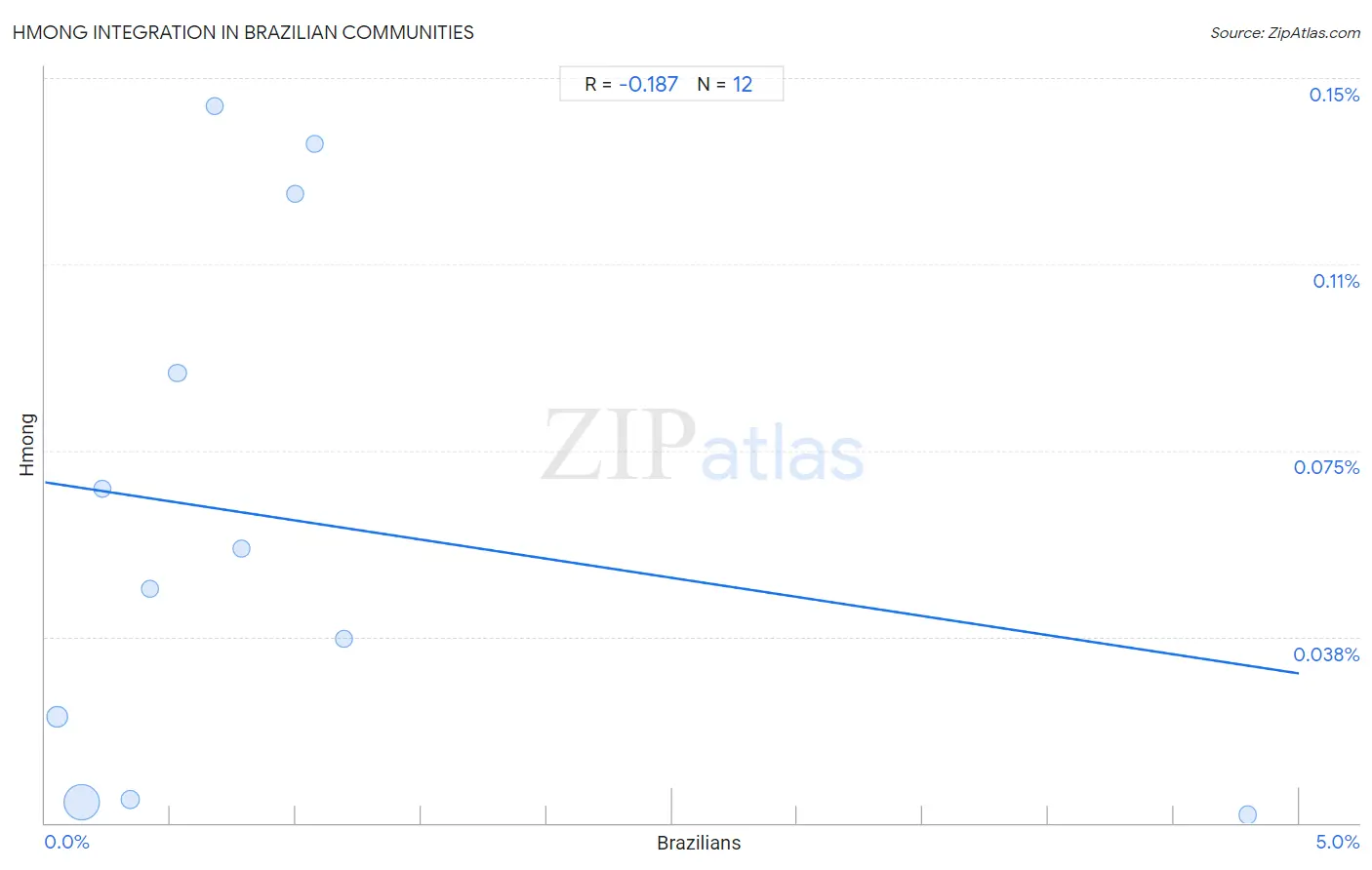
Brazilian vs Hmong Income
When considering income, the most significant differences between Brazilian and Hmong communities in the United States are seen in per capita income ($46,700 compared to $38,120, a difference of 22.5%), householder income ages 45 - 64 years ($104,408 compared to $88,115, a difference of 18.5%), and median male earnings ($56,837 compared to $48,254, a difference of 17.8%). Conversely, both communities are more comparable in terms of wage/income gap (26.7% compared to 27.7%, a difference of 3.6%), householder income over 65 years ($61,465 compared to $56,339, a difference of 9.1%), and householder income under 25 years ($54,335 compared to $49,364, a difference of 10.1%).

| Income Metric | Brazilian | Hmong |
| Per Capita Income | Exceptional $46,700 | Tragic $38,120 |
| Median Family Income | Excellent $106,942 | Tragic $91,296 |
| Median Household Income | Exceptional $88,934 | Tragic $75,839 |
| Median Earnings | Exceptional $48,356 | Tragic $42,111 |
| Median Male Earnings | Exceptional $56,837 | Tragic $48,254 |
| Median Female Earnings | Excellent $40,483 | Tragic $35,498 |
| Householder Age | Under 25 years | Exceptional $54,335 | Tragic $49,364 |
| Householder Age | 25 - 44 years | Excellent $98,267 | Tragic $84,258 |
| Householder Age | 45 - 64 years | Excellent $104,408 | Tragic $88,115 |
| Householder Age | Over 65 years | Good $61,465 | Tragic $56,339 |
| Wage/Income Gap | Tragic 26.7% | Tragic 27.7% |
Brazilian vs Hmong Poverty
When considering poverty, the most significant differences between Brazilian and Hmong communities in the United States are seen in single male poverty (11.8% compared to 14.2%, a difference of 20.8%), single female poverty (20.1% compared to 23.1%, a difference of 14.9%), and child poverty under the age of 5 (16.4% compared to 18.5%, a difference of 13.4%). Conversely, both communities are more comparable in terms of married-couple family poverty (5.0% compared to 5.0%, a difference of 0.97%), receiving food stamps (11.1% compared to 10.9%, a difference of 1.6%), and single father poverty (15.5% compared to 15.9%, a difference of 2.7%).
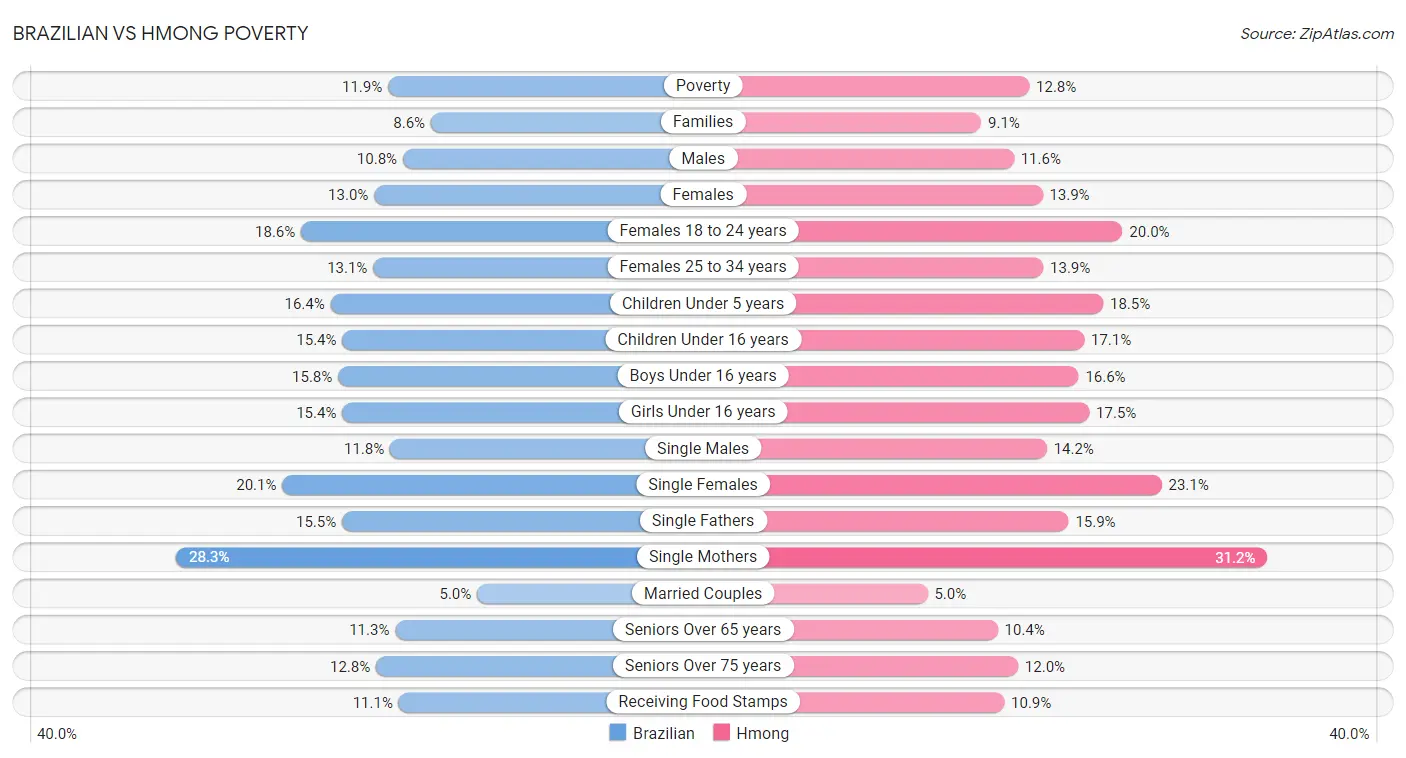
| Poverty Metric | Brazilian | Hmong |
| Poverty | Good 11.9% | Poor 12.8% |
| Families | Excellent 8.6% | Average 9.1% |
| Males | Excellent 10.8% | Poor 11.6% |
| Females | Excellent 13.0% | Fair 13.9% |
| Females 18 to 24 years | Exceptional 18.6% | Average 20.0% |
| Females 25 to 34 years | Excellent 13.1% | Fair 13.9% |
| Children Under 5 years | Excellent 16.4% | Tragic 18.5% |
| Children Under 16 years | Excellent 15.4% | Poor 17.1% |
| Boys Under 16 years | Excellent 15.8% | Fair 16.6% |
| Girls Under 16 years | Excellent 15.4% | Poor 17.5% |
| Single Males | Exceptional 11.8% | Tragic 14.2% |
| Single Females | Exceptional 20.1% | Tragic 23.1% |
| Single Fathers | Exceptional 15.5% | Exceptional 15.9% |
| Single Mothers | Exceptional 28.3% | Tragic 31.2% |
| Married Couples | Good 5.0% | Excellent 5.0% |
| Seniors Over 65 years | Poor 11.3% | Exceptional 10.4% |
| Seniors Over 75 years | Tragic 12.8% | Good 12.0% |
| Receiving Food Stamps | Excellent 11.1% | Excellent 10.9% |
Brazilian vs Hmong Unemployment
When considering unemployment, the most significant differences between Brazilian and Hmong communities in the United States are seen in unemployment among seniors over 75 years (9.3% compared to 13.7%, a difference of 48.4%), unemployment among ages 65 to 74 years (5.6% compared to 4.2%, a difference of 33.1%), and unemployment among women with children under 18 years (5.8% compared to 4.5%, a difference of 30.0%). Conversely, both communities are more comparable in terms of unemployment among women with children ages 6 to 17 years (9.1% compared to 8.7%, a difference of 4.5%), unemployment among ages 16 to 19 years (17.1% compared to 16.3%, a difference of 4.7%), and unemployment among ages 35 to 44 years (4.7% compared to 5.0%, a difference of 5.1%).
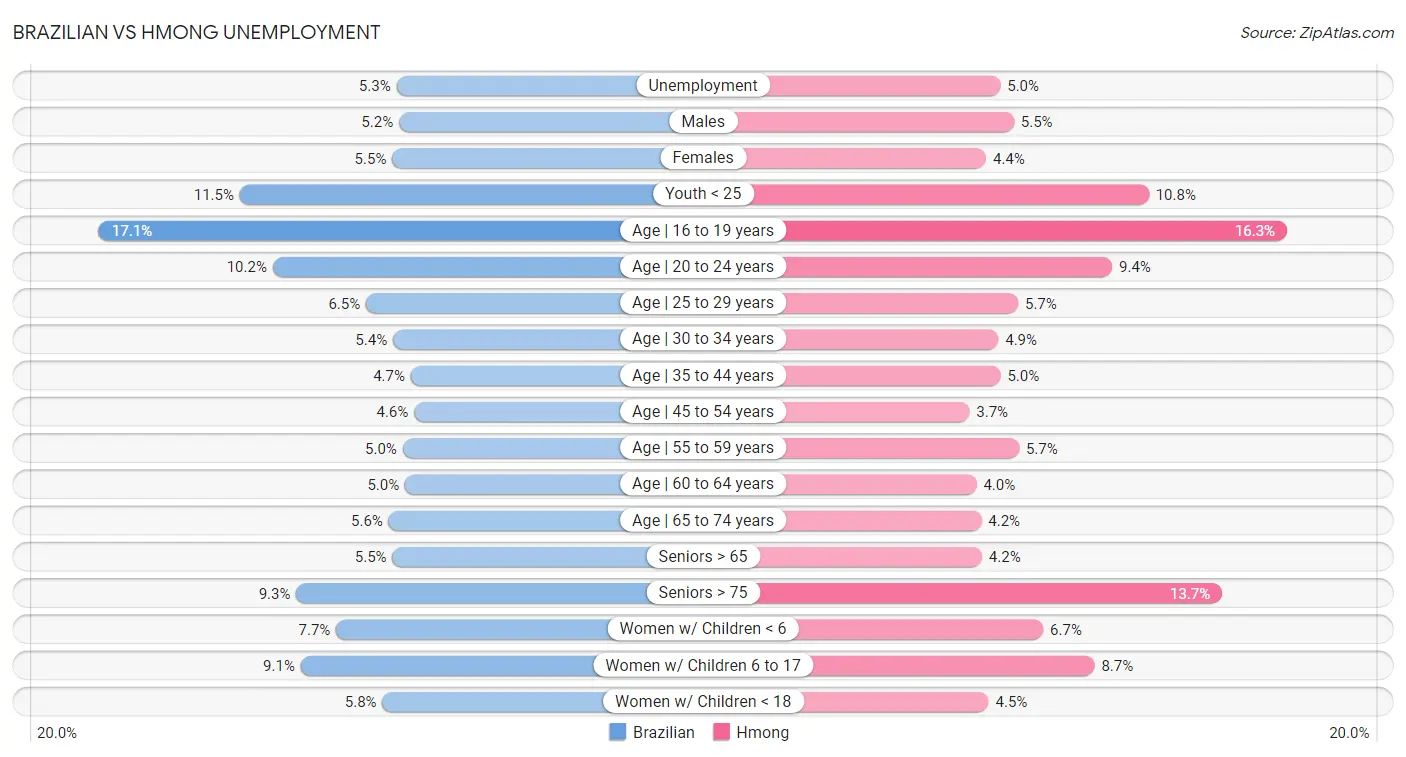
| Unemployment Metric | Brazilian | Hmong |
| Unemployment | Average 5.3% | Exceptional 5.0% |
| Males | Good 5.2% | Tragic 5.5% |
| Females | Tragic 5.5% | Exceptional 4.4% |
| Youth < 25 | Good 11.5% | Exceptional 10.8% |
| Age | 16 to 19 years | Exceptional 17.1% | Exceptional 16.3% |
| Age | 20 to 24 years | Good 10.2% | Exceptional 9.4% |
| Age | 25 to 29 years | Excellent 6.5% | Exceptional 5.7% |
| Age | 30 to 34 years | Average 5.4% | Exceptional 4.9% |
| Age | 35 to 44 years | Fair 4.7% | Tragic 5.0% |
| Age | 45 to 54 years | Fair 4.6% | Exceptional 3.7% |
| Age | 55 to 59 years | Tragic 5.0% | Tragic 5.7% |
| Age | 60 to 64 years | Poor 5.0% | Exceptional 4.0% |
| Age | 65 to 74 years | Tragic 5.6% | Exceptional 4.2% |
| Seniors > 65 | Tragic 5.5% | Exceptional 4.2% |
| Seniors > 75 | Tragic 9.3% | Tragic 13.7% |
| Women w/ Children < 6 | Average 7.7% | Exceptional 6.7% |
| Women w/ Children 6 to 17 | Fair 9.1% | Exceptional 8.7% |
| Women w/ Children < 18 | Tragic 5.8% | Exceptional 4.5% |
Brazilian vs Hmong Labor Participation
When considering labor participation, the most significant differences between Brazilian and Hmong communities in the United States are seen in in labor force | age > 16 (66.6% compared to 64.1%, a difference of 4.0%), in labor force | age 30-34 (85.4% compared to 82.4%, a difference of 3.6%), and in labor force | age 20-64 (80.5% compared to 77.9%, a difference of 3.4%). Conversely, both communities are more comparable in terms of in labor force | age 20-24 (75.8% compared to 76.5%, a difference of 1.0%), in labor force | age 25-29 (85.3% compared to 83.7%, a difference of 1.9%), and in labor force | age 45-54 (83.7% compared to 81.7%, a difference of 2.5%).

| Labor Participation Metric | Brazilian | Hmong |
| In Labor Force | Age > 16 | Exceptional 66.6% | Tragic 64.1% |
| In Labor Force | Age 20-64 | Exceptional 80.5% | Tragic 77.9% |
| In Labor Force | Age 16-19 | Excellent 37.5% | Exceptional 38.7% |
| In Labor Force | Age 20-24 | Exceptional 75.8% | Exceptional 76.5% |
| In Labor Force | Age 25-29 | Exceptional 85.3% | Tragic 83.7% |
| In Labor Force | Age 30-34 | Exceptional 85.4% | Tragic 82.4% |
| In Labor Force | Age 35-44 | Exceptional 85.0% | Tragic 82.6% |
| In Labor Force | Age 45-54 | Exceptional 83.7% | Tragic 81.7% |
Brazilian vs Hmong Family Structure
When considering family structure, the most significant differences between Brazilian and Hmong communities in the United States are seen in births to unmarried women (30.4% compared to 27.7%, a difference of 9.5%), single father households (2.2% compared to 2.4%, a difference of 6.3%), and family households with children (27.7% compared to 28.6%, a difference of 3.4%). Conversely, both communities are more comparable in terms of average family size (3.18 compared to 3.21, a difference of 0.79%), currently married (46.4% compared to 47.1%, a difference of 1.3%), and family households (63.9% compared to 64.9%, a difference of 1.6%).

| Family Structure Metric | Brazilian | Hmong |
| Family Households | Poor 63.9% | Exceptional 64.9% |
| Family Households with Children | Good 27.7% | Exceptional 28.6% |
| Married-couple Households | Fair 46.2% | Good 47.0% |
| Average Family Size | Tragic 3.18 | Fair 3.21 |
| Single Father Households | Exceptional 2.2% | Fair 2.4% |
| Single Mother Households | Average 6.2% | Fair 6.4% |
| Currently Married | Fair 46.4% | Good 47.1% |
| Divorced or Separated | Average 12.1% | Tragic 12.3% |
| Births to Unmarried Women | Excellent 30.4% | Exceptional 27.7% |
Brazilian vs Hmong Vehicle Availability
When considering vehicle availability, the most significant differences between Brazilian and Hmong communities in the United States are seen in 4 or more vehicles in household (5.4% compared to 7.0%, a difference of 29.8%), 3 or more vehicles in household (17.4% compared to 21.0%, a difference of 20.4%), and 2 or more vehicles in household (53.8% compared to 57.8%, a difference of 7.5%). Conversely, both communities are more comparable in terms of no vehicles in household (10.4% compared to 10.4%, a difference of 0.14%), 1 or more vehicles in household (90.0% compared to 89.6%, a difference of 0.41%), and 2 or more vehicles in household (53.8% compared to 57.8%, a difference of 7.5%).

| Vehicle Availability Metric | Brazilian | Hmong |
| No Vehicles Available | Average 10.4% | Average 10.4% |
| 1+ Vehicles Available | Good 90.0% | Average 89.6% |
| 2+ Vehicles Available | Tragic 53.8% | Exceptional 57.8% |
| 3+ Vehicles Available | Tragic 17.4% | Exceptional 21.0% |
| 4+ Vehicles Available | Tragic 5.4% | Exceptional 7.0% |
Brazilian vs Hmong Education Level
When considering education level, the most significant differences between Brazilian and Hmong communities in the United States are seen in professional degree (5.0% compared to 3.7%, a difference of 33.2%), doctorate degree (2.1% compared to 1.6%, a difference of 32.3%), and master's degree (16.5% compared to 13.4%, a difference of 23.5%). Conversely, both communities are more comparable in terms of 12th grade, no diploma (91.3% compared to 91.3%, a difference of 0.050%), nursery school (98.0% compared to 98.1%, a difference of 0.060%), and 11th grade (92.8% compared to 92.8%, a difference of 0.060%).
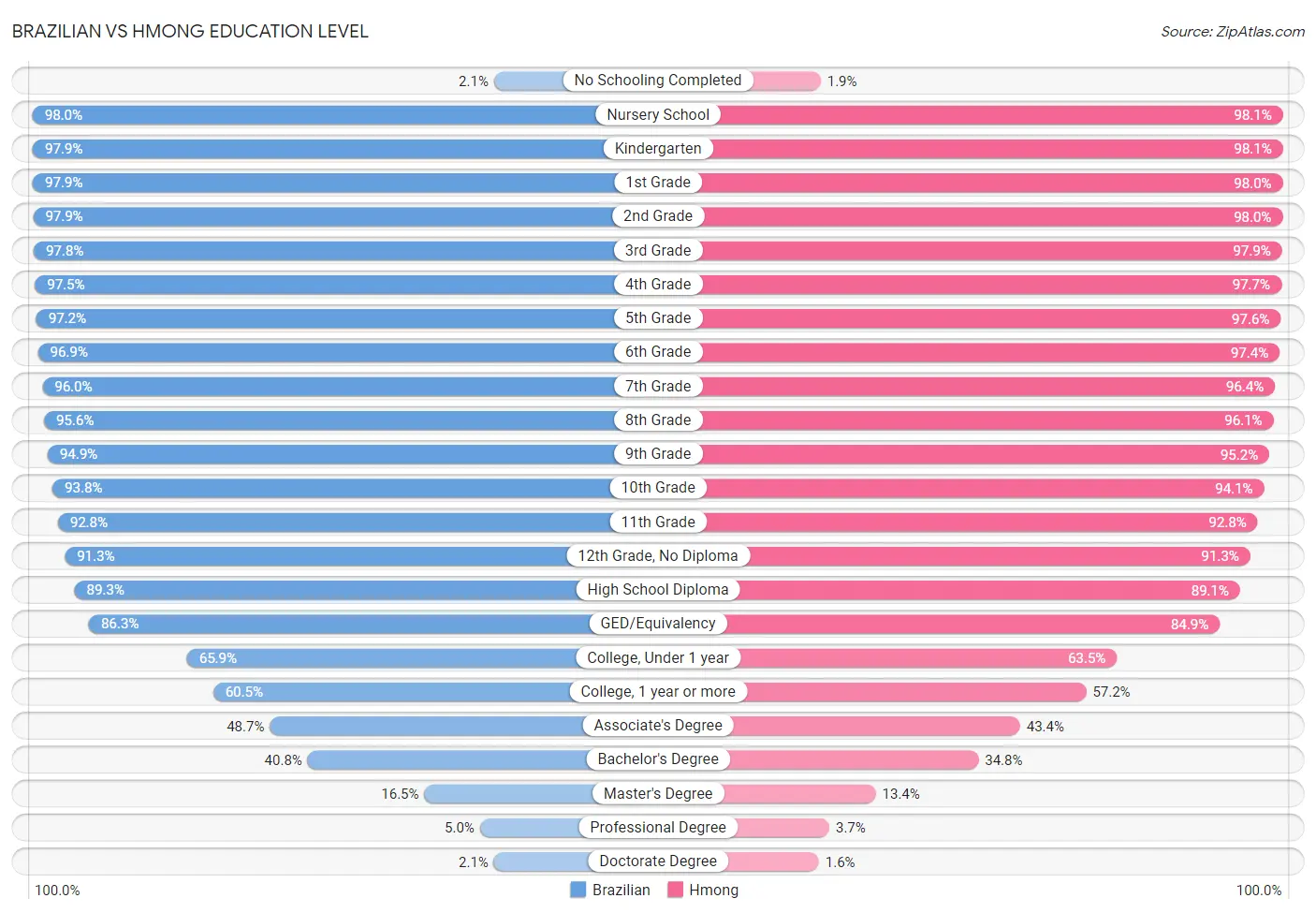
| Education Level Metric | Brazilian | Hmong |
| No Schooling Completed | Good 2.1% | Excellent 1.9% |
| Nursery School | Average 98.0% | Good 98.1% |
| Kindergarten | Average 97.9% | Good 98.1% |
| 1st Grade | Average 97.9% | Good 98.0% |
| 2nd Grade | Average 97.9% | Good 98.0% |
| 3rd Grade | Average 97.8% | Excellent 97.9% |
| 4th Grade | Average 97.5% | Excellent 97.7% |
| 5th Grade | Fair 97.2% | Exceptional 97.6% |
| 6th Grade | Fair 96.9% | Exceptional 97.4% |
| 7th Grade | Fair 96.0% | Exceptional 96.4% |
| 8th Grade | Fair 95.6% | Excellent 96.1% |
| 9th Grade | Average 94.9% | Excellent 95.2% |
| 10th Grade | Good 93.8% | Excellent 94.1% |
| 11th Grade | Good 92.8% | Good 92.8% |
| 12th Grade, No Diploma | Good 91.3% | Average 91.3% |
| High School Diploma | Good 89.3% | Average 89.1% |
| GED/Equivalency | Good 86.3% | Poor 84.9% |
| College, Under 1 year | Good 65.9% | Tragic 63.5% |
| College, 1 year or more | Good 60.5% | Tragic 57.2% |
| Associate's Degree | Exceptional 48.7% | Tragic 43.4% |
| Bachelor's Degree | Exceptional 40.8% | Tragic 34.8% |
| Master's Degree | Exceptional 16.5% | Tragic 13.4% |
| Professional Degree | Exceptional 5.0% | Tragic 3.7% |
| Doctorate Degree | Exceptional 2.1% | Tragic 1.6% |
Brazilian vs Hmong Disability
When considering disability, the most significant differences between Brazilian and Hmong communities in the United States are seen in disability age under 5 (1.5% compared to 1.1%, a difference of 28.8%), disability age 18 to 34 (6.4% compared to 8.1%, a difference of 26.6%), and disability age 35 to 64 (10.5% compared to 13.1%, a difference of 25.2%). Conversely, both communities are more comparable in terms of self-care disability (2.3% compared to 2.4%, a difference of 3.5%), disability age over 75 (46.5% compared to 48.2%, a difference of 3.8%), and vision disability (2.1% compared to 2.3%, a difference of 6.6%).
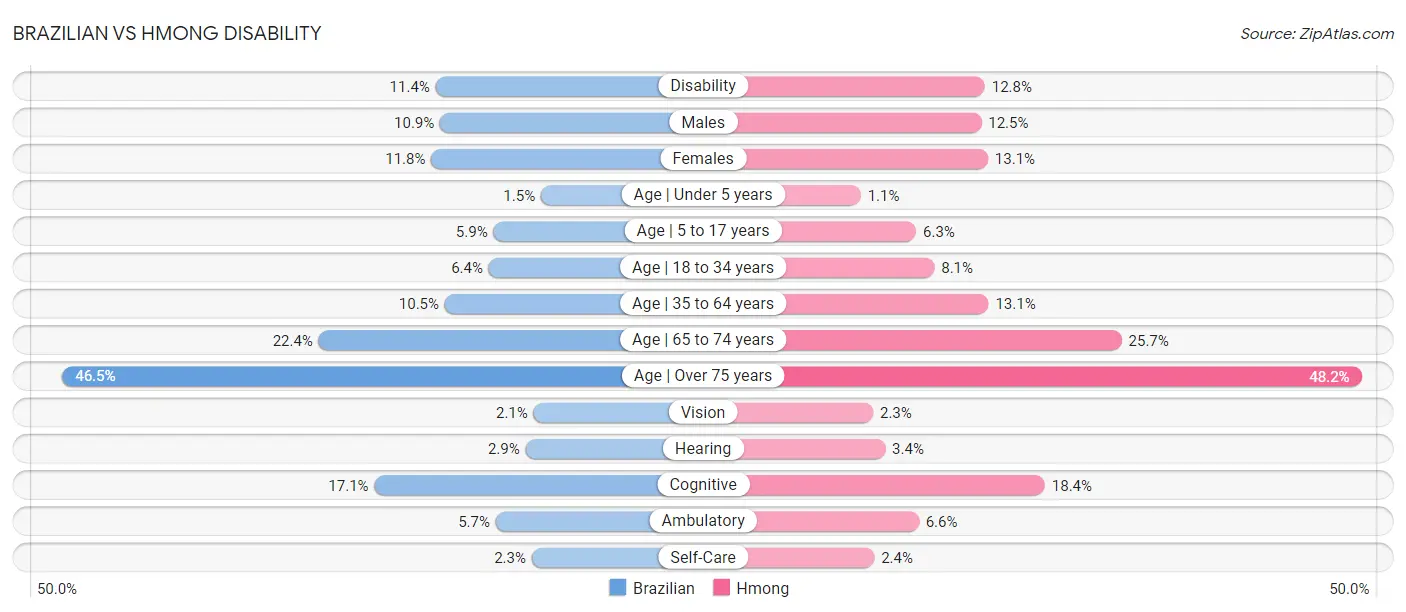
| Disability Metric | Brazilian | Hmong |
| Disability | Exceptional 11.4% | Tragic 12.8% |
| Males | Excellent 10.9% | Tragic 12.5% |
| Females | Exceptional 11.8% | Tragic 13.1% |
| Age | Under 5 years | Tragic 1.5% | Exceptional 1.1% |
| Age | 5 to 17 years | Tragic 5.9% | Tragic 6.3% |
| Age | 18 to 34 years | Excellent 6.4% | Tragic 8.1% |
| Age | 35 to 64 years | Exceptional 10.5% | Tragic 13.1% |
| Age | 65 to 74 years | Exceptional 22.4% | Tragic 25.7% |
| Age | Over 75 years | Exceptional 46.5% | Tragic 48.2% |
| Vision | Good 2.1% | Tragic 2.3% |
| Hearing | Good 2.9% | Tragic 3.4% |
| Cognitive | Good 17.1% | Tragic 18.4% |
| Ambulatory | Exceptional 5.7% | Tragic 6.6% |
| Self-Care | Exceptional 2.3% | Excellent 2.4% |